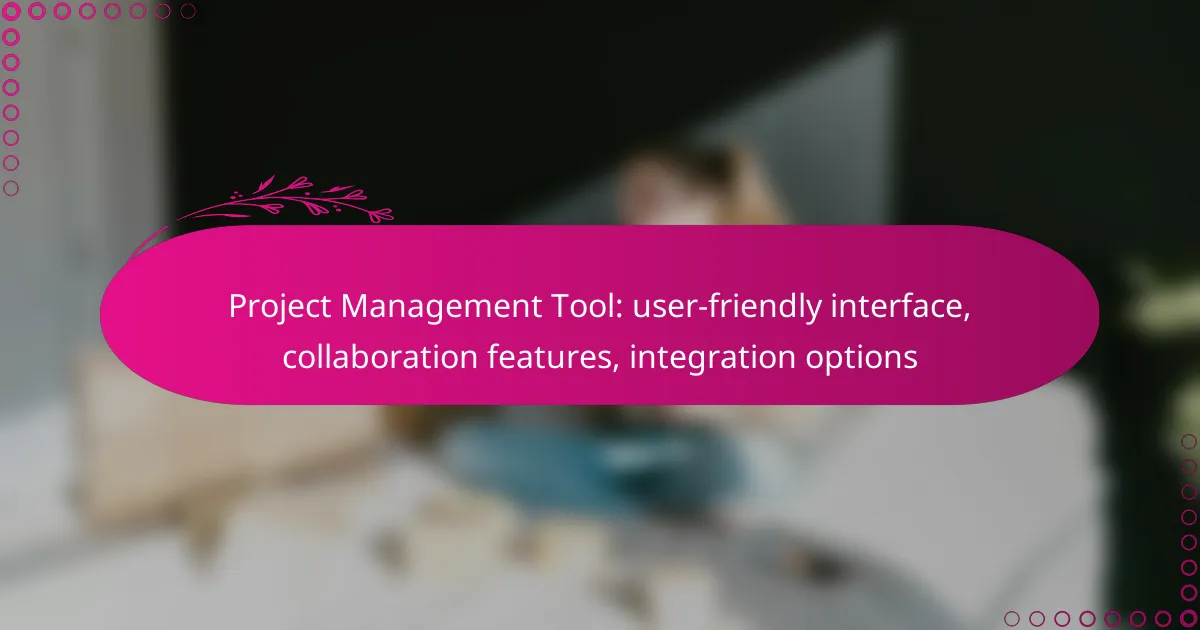Project management tools with user-friendly interfaces are essential for enhancing collaboration and streamlining workflows. These tools offer features such as real-time communication, task assignments, and file sharing, which foster effective teamwork. Additionally, integration options with other applications further enhance their functionality, making them invaluable for successful project execution.

What are the best project management tools for collaboration in Canada?
The best project management tools for collaboration in Canada combine user-friendly interfaces with robust features that enhance teamwork. These tools facilitate communication, task management, and integration with other applications, making them essential for effective project execution.
Asana
Asana is known for its intuitive interface and strong collaboration features, making it suitable for teams of all sizes. Users can create tasks, assign them to team members, and track progress through various views, including lists and boards.
One notable feature is the ability to set deadlines and dependencies, which helps teams prioritize work effectively. Asana also integrates with numerous other tools, such as Slack and Google Drive, enhancing its functionality.
Trello
Trello utilizes a card-based system that allows teams to visualize their projects easily. Each card represents a task, and users can move them across different columns to indicate progress, making it highly user-friendly.
This tool is particularly effective for smaller teams or projects that require flexibility. Trello offers integrations with various apps, and its Power-Ups feature allows users to customize their boards with additional functionalities.
Monday.com
Monday.com provides a highly customizable platform that caters to diverse project management needs. Its visual dashboard allows teams to track tasks, timelines, and workloads in real-time.
Collaboration features include file sharing and commenting directly on tasks, which streamlines communication. The platform also supports integrations with popular tools like Zoom and Microsoft Teams, making it versatile for Canadian businesses.
ClickUp
ClickUp stands out for its all-in-one approach, combining project management, document sharing, and goal tracking in a single platform. Its user-friendly interface allows teams to manage tasks, set priorities, and monitor progress efficiently.
ClickUp offers a variety of views, such as list, board, and calendar, catering to different team preferences. The tool also integrates with many applications, providing flexibility for Canadian teams looking to enhance their workflows.
Wrike
Wrike is designed for teams that require advanced project management capabilities, including Gantt charts and time tracking. Its collaborative features allow team members to communicate and share updates directly within tasks.
This tool is particularly beneficial for larger projects that need detailed planning and reporting. Wrike integrates with various tools, including Salesforce and Microsoft Office, making it a strong choice for Canadian organizations aiming for comprehensive project oversight.

How do user-friendly interfaces impact project management tools?
User-friendly interfaces significantly enhance the effectiveness of project management tools by making them more accessible and intuitive for users. A well-designed interface simplifies navigation, encourages collaboration, and streamlines workflows, ultimately leading to better project outcomes.
Increased user adoption
A user-friendly interface is crucial for increasing user adoption of project management tools. When team members find the software easy to navigate, they are more likely to engage with it consistently. This can lead to higher participation rates in project updates and discussions, fostering a collaborative environment.
For example, tools that feature drag-and-drop functionality or clear visual layouts can attract users who may otherwise be hesitant to adopt new technology. This increased adoption can significantly improve team dynamics and project efficiency.
Enhanced productivity
User-friendly interfaces contribute to enhanced productivity by reducing the time spent on learning the tool and performing tasks. When users can easily find features and understand how to use them, they can focus more on their work rather than troubleshooting software issues.
For instance, a project management tool that allows for quick task assignments and status updates can help teams maintain momentum. Features like customizable dashboards can also help users prioritize their tasks effectively, leading to better time management.
Reduced training time
With a user-friendly interface, the training time required for new users is significantly reduced. Intuitive designs allow users to learn the system through exploration rather than formal training sessions. This can be particularly beneficial for organizations with high turnover rates or those that frequently onboard new team members.
To maximize this benefit, consider providing resources such as quick-start guides or video tutorials that complement the intuitive design. This approach can further accelerate the learning curve and ensure that all team members are up to speed quickly.

What collaboration features should you look for in a project management tool?
When selecting a project management tool, prioritize collaboration features that enhance team communication and streamline workflows. Key functionalities include real-time chat, file sharing, task assignments, and commenting systems, which collectively facilitate effective teamwork and project tracking.
Real-time chat
Real-time chat allows team members to communicate instantly, reducing delays in decision-making. Look for tools that offer integrated chat features, enabling discussions without switching platforms. This can enhance responsiveness and keep conversations organized around specific projects or tasks.
Consider tools that support both one-on-one and group chats, as well as options for direct messaging and public channels. This flexibility helps cater to different communication needs within your team.
File sharing
File sharing capabilities are essential for collaborative work, allowing team members to upload, access, and edit documents easily. Choose a project management tool that supports various file formats and offers version control to track changes over time.
Ensure that the tool provides secure sharing options, such as permission settings, to protect sensitive information. Integration with cloud storage services can also enhance accessibility and streamline the sharing process.
Task assignments
Task assignments enable clear delegation of responsibilities among team members, ensuring accountability and transparency. Look for features that allow you to assign tasks with deadlines, priorities, and status updates to keep everyone informed of progress.
Tools that offer visual task boards or lists can help team members quickly understand their workload and deadlines. This clarity can improve productivity and help prevent tasks from falling through the cracks.
Commenting systems
A robust commenting system allows team members to provide feedback directly on tasks, documents, or discussions. This feature fosters collaboration by keeping all relevant conversations in one place, making it easier to track decisions and changes.
Choose a tool that supports threaded comments, so discussions remain organized and contextually relevant. Notifications for new comments can also help ensure that team members stay updated on important feedback and discussions.

How do integration options affect project management tools?
Integration options significantly enhance project management tools by enabling seamless connectivity with other software applications. This connectivity streamlines workflows, improves data accuracy, and fosters better collaboration among team members.
Seamless workflow
Seamless workflow integration allows project management tools to function smoothly with existing systems, reducing the need for manual data entry. For instance, integrating a project management tool with communication platforms can automate task updates and notifications, ensuring that all team members are on the same page.
To achieve a seamless workflow, choose tools that offer native integrations or robust APIs. This ensures that your project management software can easily connect with other applications, minimizing disruptions and enhancing productivity.
Data synchronization
Data synchronization ensures that information across various platforms remains consistent and up-to-date. When project management tools integrate with other systems, such as CRM or accounting software, data is automatically updated in real-time, reducing the risk of errors and discrepancies.
Consider tools that support two-way data synchronization, allowing updates made in one application to reflect in others. This feature is crucial for maintaining accurate project timelines and budgets, especially in larger teams where multiple users access the same data.
Access to third-party apps
Access to third-party applications expands the functionality of project management tools by allowing users to leverage specialized software for specific tasks. For example, integrating with time-tracking apps can help monitor project hours more effectively, while linking to file storage services can streamline document management.
When selecting a project management tool, evaluate the ecosystem of third-party applications it supports. A rich library of integrations can enhance your team’s capabilities and improve overall project outcomes, making it easier to tailor the tool to your specific needs.
